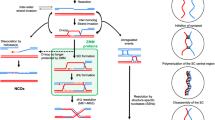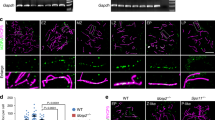Abstract
During meiosis homologous chromosomes pair and exchange homologous chromosome segments. The synaptonemal complex (SC) forms between paired chromosomes. The role of the SC in the process of reciprocal exchange of flanking markers is a matter of debate. I propose a dual pathway for reciprocal exchange of flanking markers (REFM). In the first, SC-independent, path, two ‘half-nodules’ and an independent REFM protein combine to form a functional recombination nodule (RN). The RN binds to paired chromosomes and accomplishes reciprocal exchange of flanking markers. In the other, SC-dependent, pathway ‘half-nodules’ occur at pairing initiation sites. ‘Half-nodules’ move along the SC as it forms. Assisted by an SC-bound REFM protein, ‘half-nodules’ combine to form functional RNs. I propose that different organisms rely to different extents on the two pathways, and hence rely to different extents on the SC.
Similar content being viewed by others
References
Alani E, Padmore, R, Kleckner N (1990) Analysis of wild type and rad50 mutants of yeast suggests an intimate relationship between meiotic chromosome synapsis and recombination.Cell 61: 419–436.
Albini SM, Jones GH (1987) Synaptonemal complex spreading inAllium cepa andA. fistulosum. I. The initiation and sequence of pairing.Chromosoma 95: 324–338.
Anderson LK, Stack S (1988) Nodules associated with the axial cores and synaptonemal complexes during zygotene inPsilotum nudum. Chromosoma97: 96–100.
Ashley T (1994) Mammalian meiotic recombination: a reexamination.Hum Genet 94: 587–593.
Bahler J, Wyler T, Loidl J, Kohli J (1993) Unusual structures in meiotic prophase of fission yeast: a cytological analysis.J Cell Biol 121: 241–256.
Bhargava J, Engebrecht J, Roeder GS (1992) The rec102 mutant of yeast is defective in meiotic recombination and chromosome synapsis.Genetics 130: 59–69.
Bishop DK (1994) RecA homologs Dmc1 and Rad 51 interact to form multiple nuclear complexes prior to meiotic chromosome synapsis.Cell 79: 1081–1092.
Carpenter ATC (1987) Gene conversion, recombination nodules, and the initiation of meiotic synapsis.Bioessays 6: 232–236.
Dresser, ME, Giroux CN (1988) Meiotic chromosome behavior in spread preparations of yeast.J Cell Biol 106: 567–573.
Egel R (1978) Synaptonemal complexes and crossing over: structural support or interference?Heredity 41: 233–237.
Egel-Mitani M, Olson LW, Egel R (1982) Meiosis inAspergillus nidulans: another example for lacking synaptonemal complexes in the absence of interference.Hereditas 97: 179–187.
Greenbaum IF, Hale DW, Fuxa KP (1986) The mechanism of autosomal synapsis and the substaging of zygonema and pachynema from deer mouse spermatocytes.Chromosoma 93: 203–212.
Haaf T, Golub EI, Reddy G, Radding CM, Ward DC (1995) Nuclear foci of mammalian Rad 51 recombination protein in somatic cells after DNA damage and its localization in synaptonemal complexes.Proc Natl Acad Sci USA 92: 2298–2302.
Hawley RS (1980) Chromosomal sites necessary for normal levels of meiotic recombination inDrosophila melanogaster. I. Evidence for and mapping of the sites.Genetics 94: 625–646.
Hollingsworth NM, Byers B (1989) Hop1:a yeast meiotic pairing gene.Genetics 121: 445–462.
King JS, Mortimer RK (1990) A polymerization model of chiasma interference and corresponding computer simulation.Genetics 126: 1127–1138.
Loidl J (1994) Cytological aspects of meiotic recombination.Experientia 50: 285–294.
Loidl J, Jones GH (1986) Synaptonemal complex spreading inAllium. I. TriploidA. sphaerocephalon.Chromosoma 93: 420–428.
McKim KS, Peters K, Rose AM (1993). Two types of sites required for meiotic chromosome pairing inCaenorhabditis elegans.Genetics 134: 749–768.
Maguire M (1988) Crossover site determination and interference.J Theor Biol 134: 565–570.
Menees TM, Ross-Macdonald PB, Roeder GS (1992). MEI4, a meiosis-specific yeast gene required for chromosome synapsis.Mol Cell Biol 12: 1340–1351.
Orr-Weaver TL, Szostak JW (1985) Fungal recombination.Microbiol Rev 49: 33–58.
Rockmill B, Roeder GS (1990) Meiosis in asynaptic yeast.Genetics 126: 563–574.
Schmekel K, Wahrman J, Skoglund DB (1993) The central region of the synaptonemal complex inBlaps cribosa studied by electron microscope tomography.Chromosoma 102: 669–681.
Ross-Macdonald P, Roeder GS (1994) Mutation of a meiosis-specific MutS homolog decreases crossing over but not mismatch correction.Cell 79: 1069–1080.
Sym M, Roeder GS (1994) Crossover interference is abolished in the absence of a synaptonemal complex protein.Cell 79: 283–292.
Sym M, Engebrecht J, Roder GS (1993) Zip1 is a synaptonemal complex protein required for meiotic chromosome synapsis.Cell 72: 365–378.
von Wettstein D, Rasmussen SW, Holm PB (1984) The synaptonemal complex in genetic segregation.Ann Rev Genet 18: 331–413.
Wise D, Taylor JL (1995) On the mechanism of homologous synapsis in lycosid spiders.Genome 38: 443–449.
Author information
Authors and Affiliations
Additional information
accepted for publication by H. C. Macgregor
Rights and permissions
About this article
Cite this article
Hasenkampf, C.A. The synaptonemal complex — the chaperone of crossing over. Chromosome Res 4, 133–140 (1996). https://doi.org/10.1007/BF02259706
Received:
Revised:
Accepted:
Issue Date:
DOI: https://doi.org/10.1007/BF02259706




